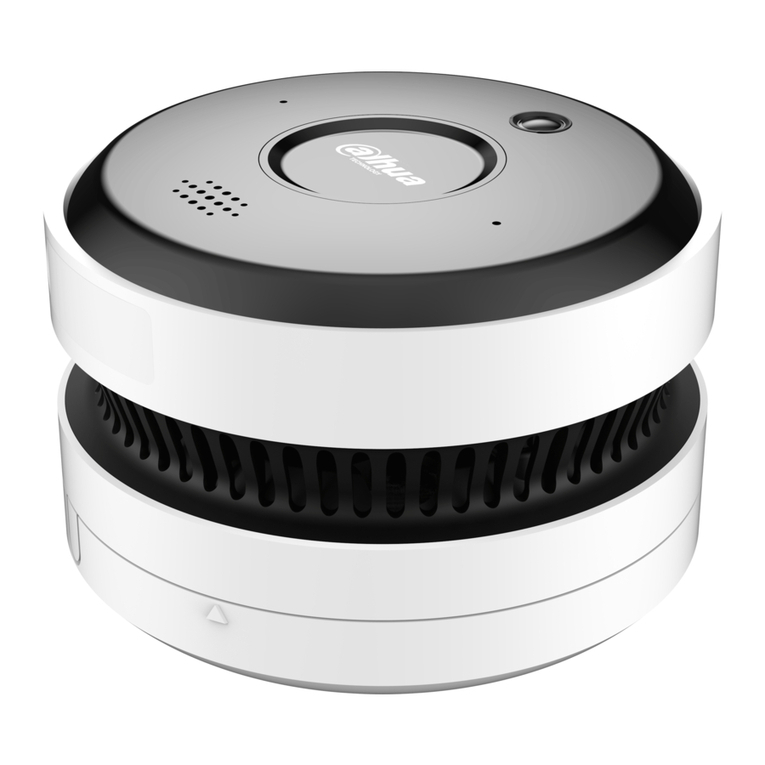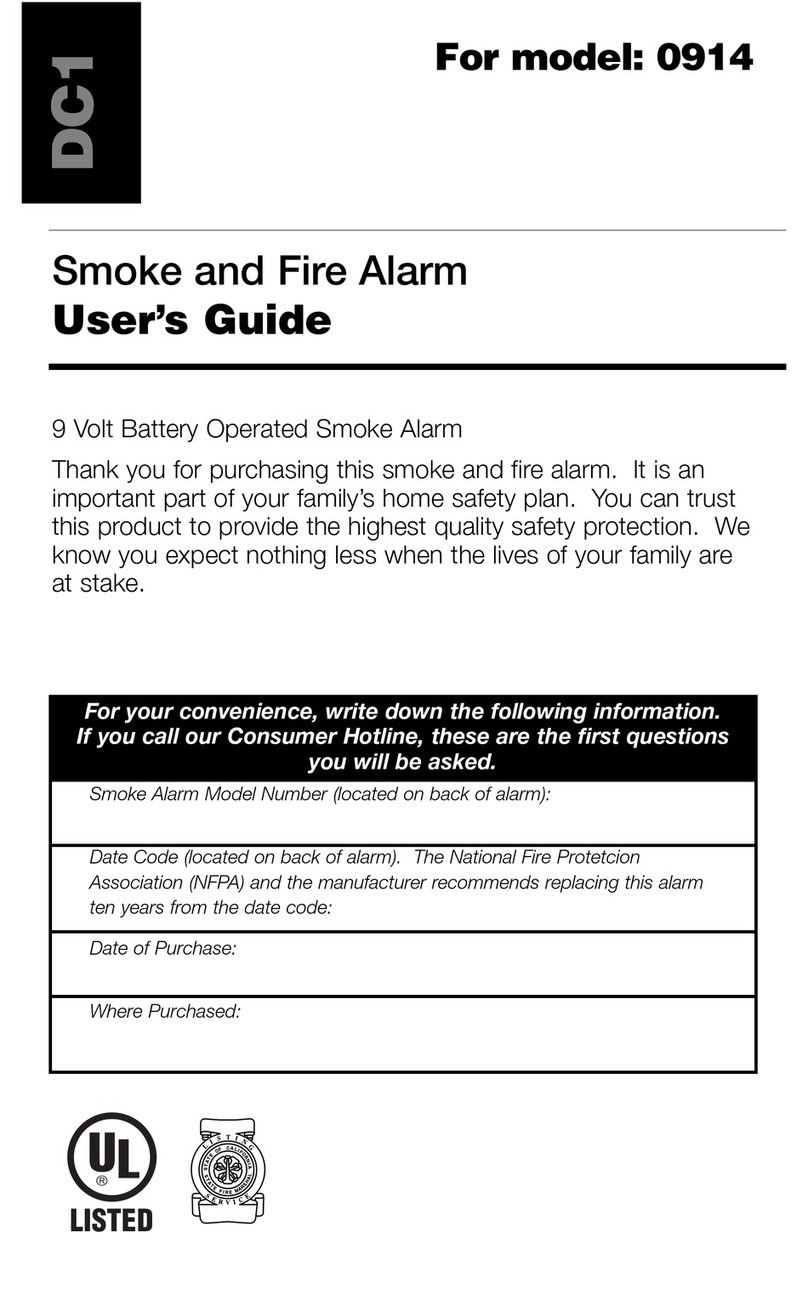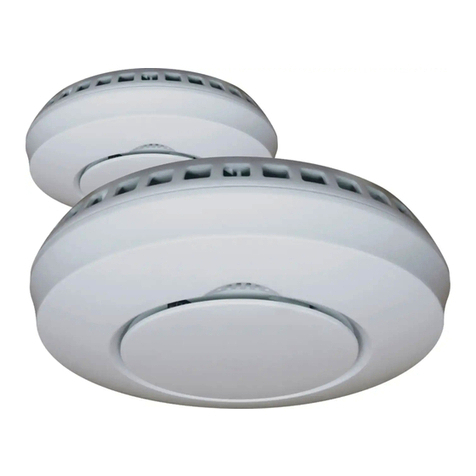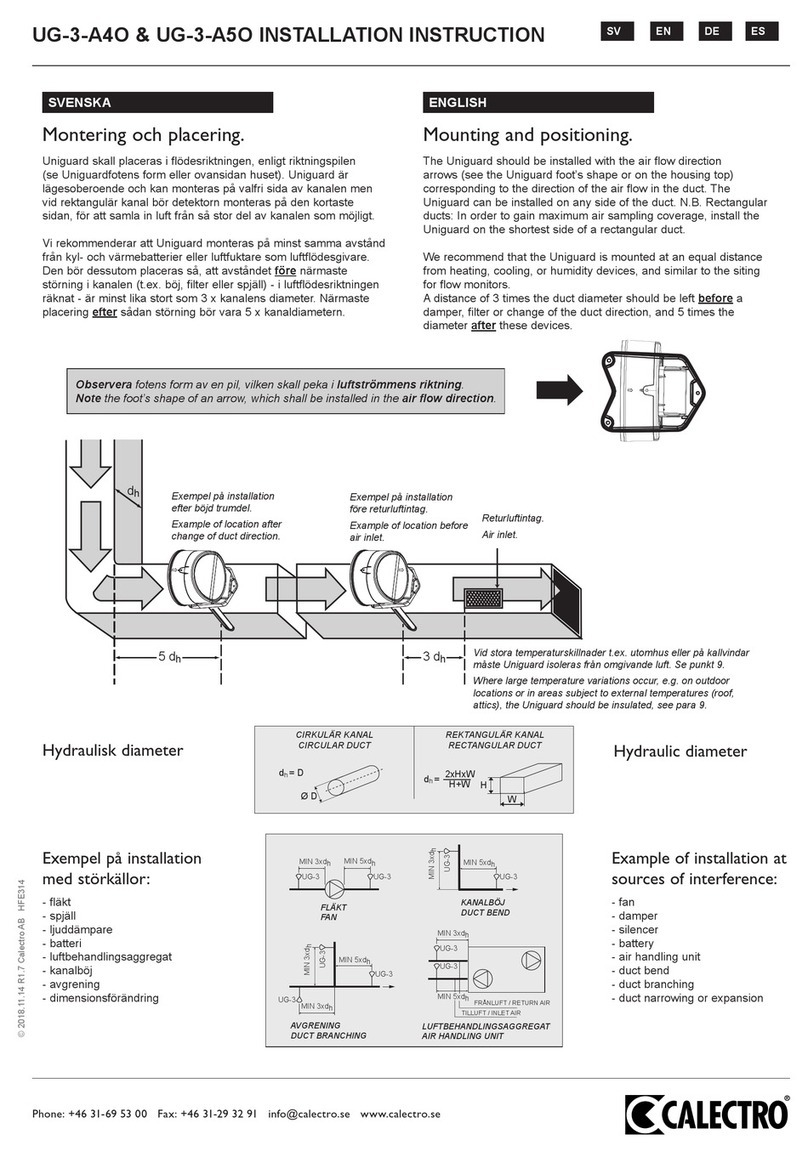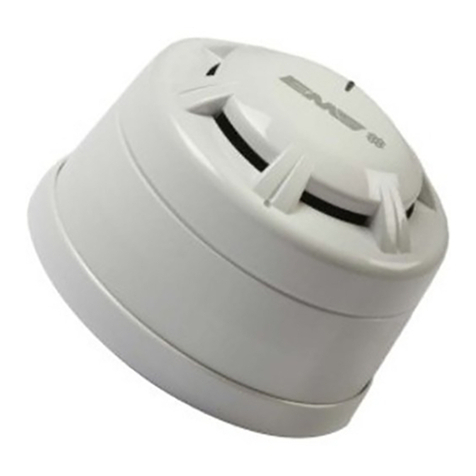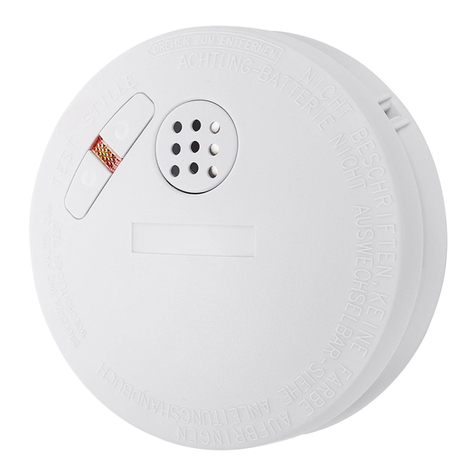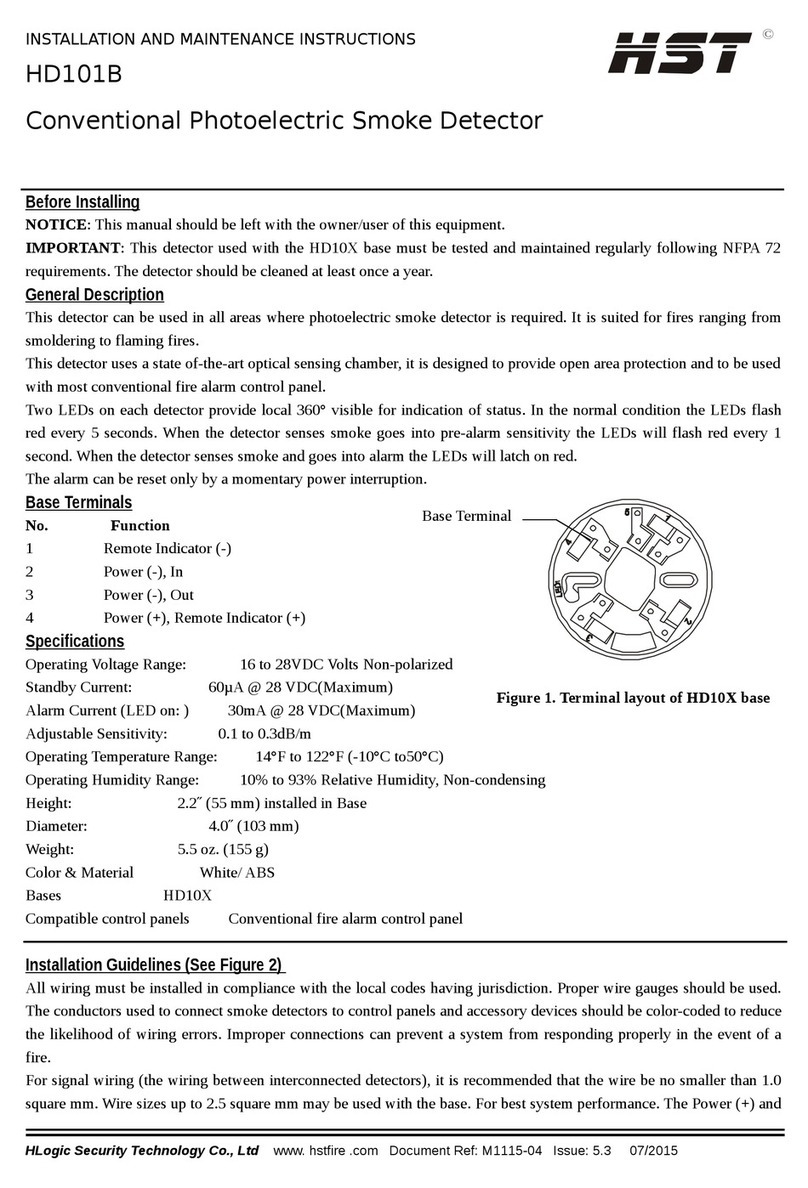Metasys 6424 User manual

Fire Initiating Devices and Notification Appliances Technical Manual 408
Conventional Products Section
Technical Bulletin
Issue Date 1095
© 1995 Johnson Controls, Inc. 1
Code No. LIT-408157
Introduction Page 3
●
General Description 3
●
Detector Placement 7
Installation Procedures 11
●
General Information 11
●
Mounting Brackets 11
●
Mounting Figures 12
●
Wiring Installation Guidelines 13
●
Installation 16
●
Alignment 19
●
Sensitivity 23
Testing and Maintenance Procedures 25
●
Sensitivity Testing 25
●
Maintenance 26
●
Limitations 27
6424 Projected Beam Type Smoke Detector

2 Conventional Products—6424 Projected Beam Type Smoke Detector

Conventional Products—6424 Projected Beam Type Smoke Detector 3
Introduction
This document contains important information about installing and
operating 6424 long distance projected beam type smoke detectors. These
conventional detectors are manufactured by System Sensor for use with
Johnson Controls systems. If you install this detector for someone else to
use, you must leave a copy of this document with the user.
These instructions provide information regarding placement, mounting,
wiring, installation, alignment, sensitivity, sensitivity testing, and
maintenance. Follow only those instructions that apply to the model you
are installing.
Before you install any 6424 long distance projected beam type smoke
detectors, read and be familiar with:
●System Sensor Guide for Proper Use of System Smoke Detectors
Technical Bulletin in the Fire Initiating Devices and Notification
Appliances Technical Manual (FAN 408) that provides detailed
information on detector spacing, placement, zoning, wiring, and
special applications
●or, for non-United States installations, applicable codes and standards
specific to country and locality of installation
Failure to follow these directions may result in failure of this device to
report an alarm or trouble condition or respond properly to an alarm
condition. Johnson Controls is not responsible for devices that have been
improperly installed, tested, or maintained by others.
The 6424 is a long range projected beam smoke detector designed to
provide open area protection. It is to be used with UL Listed, separately
supplied power (4-wire) control panels only. The detector consists of a
separate transmitter and receiver. Smoke entering the area between the
transmitter and receiver causes an obscuration in signal at the receiver.
When the obscuration reaches one of two predetermined thresholds
(chosen with a switch in the receiver), the detector generates an alarm
signal. Complete blockage of the beam causes a trouble signal to avoid
false alarms. Slow changes in obscuration due to a build up of dirt or dust
on the lens of the detector are compensated for by a microcontroller,
which continuously monitors the signal strength and periodically updates
the alarm and trouble thresholds. When the self-compensation circuit
reaches its limit, the detector generates a trouble signal, indicating the
need for service.
General
Description

4 Conventional Products—6424 Projected Beam Type Smoke Detector
Three Light Emitting Diodes (LEDs) at the receiver indicate the status of
the detector (see Table 1).
Table 1: LED Indication
Color Status
Red Alarm
Yellow Trouble
Pulsing Green Standby Operation
The alarm signal latches the alarm contact in the receiver. There are three
methods of resetting the receiver:
●momentary interruption of power to the receiver
●activation of the remote test/reset station model RTS451
●the local reset button located behind the rear door in the receiver
A trouble signal automatically resets upon removing the cause of trouble.
In addition to these indicators, there are four LEDs on both the receiver
and the transmitter which are used as a beam alignment aid. No additional
equipment is needed for alignment of the beam.
Each detector contains one Form-A (normally open) contact for alarm
signals and one Form-B (normally closed) contact for trouble signals.
Supervision of power is accomplished by installing a power supervisory
End-of-Line (EOL) relay module (model A77-716B) at the end of the
detector power circuit. When power is applied to and through the
detectors, the EOL power supervisory module is energized. The relay
contacts, along with the detector’s trouble relay contacts, provide a closed
series circuit in the control panel’s Initiating Device Circuit (IDC). A loss
in power or a trouble condition at the detector causes the respective EOL
or trouble relay to open, resulting in a trouble signal at the control panel.

Conventional Products—6424 Projected Beam Type Smoke Detector 5
Table 2: Parts List
Description Quantity
Receiver Unit 1
Transmitter Unit 1
Receiver Wiring Cable 1
Transmitter Wiring Cable 1
Wall Mounting Bracket 2
Ceiling Mounting Bracket (inside part) 2
Ceiling Mounting Bracket (outside part) 2
Wall Bracket Screw 2
Ceiling Bracket Screw 2
Washers 4
Allen Wrench 1
Instruction Manual 1
Test Filter (Part No. F37-01-00) 1
Cable Exit Plug 1
Hole Plug 1
BMB Kit (Model 6424A only) 1

6 Conventional Products—6424 Projected Beam Type Smoke Detector
Table 3: Specification Summary
General
Range 30 to 330 ft
Sensitivity 30% ±5% Total Obscuration or
55% ±5% Total Obscuration
Response Time
Alarm 15 Seconds Maximum
Trouble 15 Seconds Maximum
Trouble Condition 95% or More Obscuration
Improper Initial Alignment
Self-compensation limit reached
(service needed)
Test/Reset Features Obscuration Filters (ALARM/NO ALARM)
Local Alarm Reset Switch
Remote Test and Reset Switch Capability
(compatible with RTS451 Test Station
with Magnet)
Indicators
Alarm Remote Output
Local LED (red)
Trouble Remote Output
Local LED (yellow)
Normal Operation Local LED (flashing green)
Alignment Aid LED Bar Graph (four red LEDs)
Relays Alarm
Trouble
Environmental
Temperature –30 to 55°C (–22 to 131°F)
Humidity 95% RH, Non-condensing
Mechanical
Weight
Receiver 1.5 lb (663 g)
Transmitter 1.3 lb (598 g)
Mounting Ceiling or Wall,
Separate Mounting Brackets Provided
Wiring Plug with Attached Cable
Adjustment Angle
Ceiling ±30° Horizontal/60° Vertical
Wall ±90° Horizontal/60° Vertical
Electrical (Receiver)
Voltage 20 to 32 VDC
Maximum Ripple Voltage 30% of Nominal (Peak-to-Peak)
Current (24 VDC)
Standby 10 mA Maximum
Alarm 28.4 mA Maximum
Continued on next page . . .

Conventional Products—6424 Projected Beam Type Smoke Detector 7
Table 3: (Cont.) Specification Summary
Current
Trouble 27.1 mA Maximum
Startup Surge 19 mA Maximum
Relay Contacts 0.5A at 30 VAC/DC
Reset Time 0.6 Seconds Maximum
Startup Time (after 5 min. reset) 1 Minute Maximum
Power Loss Retain Memory for 5 Minute Minimum
Electrical (Transmitter)
Voltage 18.8 to 32 VDC
Maximum Ripple Voltage 30% of Nominal (Peak-to-Peak)
Current (24 VDC) 10 mA Maximum
When placing detectors, always comply with the requirements of
applicable standards such as National Fire Protection Association (NFPA)
72-National Fire Alarm Code as well as directives of the authority having
jurisdiction.
Projected beam detectors are usually located with their beams parallel to
the ceiling. However, they can be mounted vertically or at any angle to
protect the area involved. Since beam detectors sense the smoke buildup
over a distance, they are ideal for locations with high ceilings. They can
also be mounted on a wall or ceiling below the level of a spot type
detector, reducing the effects of air stratification. Some typical locations
would include large areas with high ceilings such as atriums, warehouses,
and factories.
Some fire codes specify spacing on a given center-to-center distance
between detectors under ideal conditions. These spacing is based on
rooms with smooth ceilings and no physical obstructions between the
contents being protected and the detectors. Moreover, they are also based
on a maximum ceiling height, and on the assumption that the value and the
combustible nature of the contents of the room being protected do not
warrant greater protection or closer spacing.
In a room with a smooth ceiling, a spacing of 30 feet but not more than
60 feet between projected beams is recommended. One-half that spacing
between the beam and the sidewall may be used as a guide (Figure 1).
The beam detector can be mounted with the receiver on one wall, the
transmitter on the opposite wall, both suspended from the ceiling or any
wall/ceiling combination. When wall mounting, the beam detector must
be 18 inches or closer to the ceiling to meet NFPA and UL requirements.
In the case of the ceiling mount, the distance from the end walls should not
exceed one-quarter of the selected spacing (7.5 feet maximum if the
spacing is 30 feet, Figure 2).
Detector
Placement

8 Conventional Products—6424 Projected Beam Type Smoke Detector
ceil
g
ph1
1 ft.
1/2 S S
Wall
Figure 1: Spacing for Smooth Ceiling--Side View
ceil
g
ph3
30 ft. Min
330 ft. Max
TX RX
TX RX
S
1/2 S Max
1/4 S
Max
Figure 2: Spacing for Smooth Ceiling--Top View
In the case of peaked or sloped ceilings, codes may specify spacing of
detectors by using horizontal spacing from the peak of the roof or ceiling.
Figures 3 and 4 show the spacing for both the shed type and peaked type
sloped ceilings.
ceil
g
ph4
S3 ft. Max S 1/2 S Max
TX
RX

Conventional Products—6424 Projected Beam Type Smoke Detector 9
Figure 3: Sloped Ceiling (Shed Type)
S S
3 ft. Max
3 ft. Max
1/2 S
Mount Detector
An
y
where in This Area
ceil
g
ph2
1/2 S
TX RX
Figure 4: Sloped Ceiling (Peaked Type)

10 Conventional Products—6424 Projected Beam Type Smoke Detector

Conventional Products—6424 Projected Beam Type Smoke Detector 11
Installation Procedures
This section contains installation information for the 6424 long distance
projected beam type smoke detectors. Instructions are given for mounting,
wiring, installing, and aligning the detector, and basic sensitivity
information is provided.
1. Install a ceiling or wall bracket for both the receiver and transmitter so
that when mounted, the receiver and the transmitter will be at
approximately the same height.
2. Assemble each ceiling bracket with the inside part between the ceiling
and the outside part as shown (Figure 5).
3. Mount the brackets so that the slot in the front of each bracket is
facing the other bracket.
4. Mount the brackets only on solid structures of the building.
5. To avoid unwanted alarms due to wall movement, do not mount to
flexible walls, such as sheet metal walls.
6. Mount the brackets with a separation of at least 30 feet but not more
than 330 feet.
dtallbl
y
Ceilin
g
Inside Part
Slot in Front
of Bracket
Outside Part
Ceilin
g
Screws
Figure 5: Ceiling Mounting Bracket Assembly
General
Information
Mounting
Brackets

12 Conventional Products—6424 Projected Beam Type Smoke Detector
Figure 6: Wall Mounting
Mounting
Figures
Hole Plu
g
Horizontal
Ad
j
ustment Screw
(
No. 10-24 x 1-3/8 in.
)
Metal
Washer
Plastic
Washer
Mountin
g
Hole
Mountin
g
Hub
"U" Bracket
Vertical
Ad
j
ustment
Screws
(
2
)
Cable E
g
ress.....
Hole Plu
g
Used to.....
Plu
g
Unused Hole....
Ali
g
nment Ad
j
ust
Potentiometer
(
Receiver Onl
y
)
Status LEDs
(
Receiver Onl
y
)
Beam Lens Ali
g
nment
LEDs
detecwa1
W all Mountin
g
Bracket

Conventional Products—6424 Projected Beam Type Smoke Detector 13
Figure 7: Ceiling Mounting
Always install all wiring in compliance with the National Electrical Code
(NEC), the applicable local codes, and any special requirements of the
local authority having jurisdiction. Proper wire gauges and suitable means
for strain relief should be used. The conductors used to connect beam
smoke detectors to control panels and accessory devices should be
color-coded to reduce the likelihood of wiring errors. Improper
connections can prevent a system from responding properly in the event
of a fire.
Installation wire used for the beam detector shall be no smaller than
No. 18 AWG (1.0 square mm). For best system performance, all fire
system wiring should be a twisted pair and installed in a grounded conduit
separate from other electrical wiring.
Note: Do not mix fire system wiring in the same conduit as any other
electrical wiring.
Shielded cable may be used to provide additional protection against
electrical interference.
Hole Plu
g
Horizontal
Ad
j
ustment Screw
(
No. 10-24 x 2-1/4 in.
)
Metal
Washer
Plastic
Washer
Mountin
g
Holes
Mountin
g
Hub
"U" Bracket
Vertical
Ad
j
ustment
Screws
(
2
)
Cable E
g
ress.....
Hole Plu
g
Used to.....
Plu
g
Unused Hole....
Ali
g
nment Ad
j
ust
Potentiometer
(
Receiver Onl
y
)
Status LEDs
(
Receiver Onl
y
)
Beam Lens
Ali
g
nment
LEDs
detecwa2
Ceilin
g
Mountin
g
Bracket
Wiring
Installation
Guidelines

14 Conventional Products—6424 Projected Beam Type Smoke Detector
When installing the beam smoke detector in applications where the
flexible conduit will be used (all Canadian applications), the Beam
Mounting Bracket (BMB) kit must be installed with the cable before
wiring the unit, as per the instructions supplied with the kit. For
applications that require the flexible conduit to be mounted to the
beam smoke detector, the model BMB kit can be ordered separately.
The BMB kit is included with the Canadian model 6424A.
In those applications where the model BMB kit is not used, the
two connectors with attached cable (6 conductor for the transmitter and
16 conductor for the receiver) can be wired before the detector is mounted.
1. Remove the precut insulation from the conductor to be connected.
2. Use a wire nut to connect the detector wire to the field wire.
If the insulation has been removed from any unused conductors, make
sure they are terminated properly to avoid short circuits.
3. Wire the transmitter in either of two ways.
●Use a connecting pair of wire to permanently connect the
transmitter to the receiver. The transmitter receives its power
along with communication for the alignment aid through the
connecting pair of wires (Figure 8). Temporary wiring can be
installed for the communication needed for transmitter alignment
aid.
●Use a remote power source to power the transmitter as an
alternative wiring configuration. Make sure the remote power
source complies with all codes and directives of the authority
having jurisdiction (Figure 9).
Wiring the 6424
Model

Conventional Products—6424 Projected Beam Type Smoke Detector 15
Figure 8: Transmitter Permanently Wired to Receiver
Figure 9: Transmitter Powered Separately
Transmitter
Listed
EOL Power
Supervision
Rela
y
Module
(
Shown Ener
g
ized
)
Oran
g
e
Blue
Green
Transmitter
Receiver
Oran
g
e
Blue
Green
Green
Receiver
White-Black
Stripe
Brown
White-Violet
Stripe
Violet
Gra
y
Black
Red-White
Stripe
White-
Yellow
Stripe
White
Class A
Return Loop
Initiatin
g
Loop
Power to
Detectors
UL Listed Panel
White-Red
Stripe
For proper supervision,
an EOL rela
y
must be used.
Brown
White-
Violet Stripe
White-
Red
Stripe
Violet
Gra
y
Green
Black
Red-White
Stripe
White-
Yellow
Stripe
White
White-Black
Stripe
EOL
Resistor
beam1
Note:
Transmitter
EOL
Resistor
Oran
g
e
Black
Green
Red
Transmitter
Receiver
Oran
g
e Green
Receiver
White-Black
Stripe
Brown
White-Violet
Stripe
Violet
Gra
y
Black
Red-White
Stripe
White-
Yellow
Stripe
White
beam2
Class A
Return Loop
Power to
Detectors
UL Listed Panel
Listed
Remote
Power
Source
Black Red
Power
inputs to
transmitter are
nonpolar.
Initiatin
g
Loop
Green
Blue
Green
Blue
White
Brown
Listed
EOL Power
Supervision
Rela
y
Module
(
Shown Ener
g
ized
)
For proper supervision,.....
an EOL rela
y
must be used......
White-Red
Stripe
Brown
White-
Violet
Stripe
White-
Red
Stripe
Violet
Gra
y
Optional Temporar
y
Wirin
g
for Transmitter.....
Ali
g
nment Aid......
Black
Red-White
Stripe
W hite-Yellow
Stripe
White
White-Black
Stripe
Note:
.....

16 Conventional Products—6424 Projected Beam Type Smoke Detector
●For information on the remote outputs for trouble and alarm, see
Figure 10.
●For the connection necessary for using the remote test station
(RTS451) see Figure 11.
The test coil which is shipped with the RTS451 is not used on the
6424 beam smoke detector.
beam wir2
Alarm
Si
g
nal
Power
(
+
)
Power
(
-
)
White-Green Stripe
White-Brown Stripe
Oran
g
e
Trouble
Si
g
nal
6424 Remote Outputs
Figure 10: Remote Annunciators
beamwr2a
Alarm Si
g
nal
Aux
(
-
)
Reset
Test Blue
Yellow
Oran
g
e
White-Brown Stripe
5
3
4
2
1
RTS451
Remote Test Station
6424
Figure 11: Remote Test Station
!
WARNING: Shock hazard. Disconnect the power from the
Initiating Device Circuits (IDC) before installing
the detectors.
1. Before operation, remove the clear protective film and warning label
on the smoked lens of both the receiver and transmitter.
2. Do not remove the protective film until all construction in the area is
completed and all dust has been removed.
If construction occurs after the protective film is removed, the smoked
lens should be cleaned after construction is completed and the area
cleaned.
For instructions, read and be familiar with the Maintenance section of
this technical bulletin.
Installation

Conventional Products—6424 Projected Beam Type Smoke Detector 17
3. To remove:
●grasp a free corner of the protective film and warning label.
●peel them from the lens of both the receiver and transmitter.
4. Mount brackets and connect cables properly as described in the
Mounting Brackets and Wiring Installation Guidelines sections of
this technical bulletin.
In any applications where the BMB kit is used, it should be installed
before the detector is mounted. Instructions for mounting the BMB
are included in the BMB kit.
5. Insert the flange of the detector mounting bracket into the keyed hole
of the wall or ceiling mounting bracket.
6. Slide the detector forward into position. The detector should now
hang from the bracket.
7. Insert the correct screw and washer combination (either wall or
ceiling mount) through the slot and into the hole of the mounting
bracket flange.
8. Tighten the screw until almost snug. The detector should still turn
easily in both directions.
9. Open the sliding access door on the back of the unit.
10. Plug cable connector into the slot in the metal barrier, observing
proper orientation (Figures 12 and 13).
11. Repeat for the other unit.

18 Conventional Products—6424 Projected Beam Type Smoke Detector
Figure 12: Rear View Receiver
Figure 13: Rear View Transmitter
Access Door
detecwa5
30 55
NA
Sensitivit
y
Select Switch
Ali
g
nment
Mode Switch
Reset Switch Connector 16.....
Conductor.....
Cable.....
Access Door
detecwa6
AN
L
S
Ran
g
e
Select Switch
Ali
g
nment
Mode Switch
6.....
Conductor.....
Cable.....
SW1
SW2
Connector

Conventional Products—6424 Projected Beam Type Smoke Detector 19
Four red LEDs used
for ali
g
nment.
Receiver
Transmitter
Green:
Yellow:
Red:
Flashes approximatel
y
ever
y
two seconds if powered up and
sensin
g
a safe condition.
Turns on while a trouble
condition exists.
Turns on if an alarm
condition is sensed.
Latches on until reset.
Not
Used
deteca4
Figure 14: Front View Transmitter and Receiver
Ali
g
nment Ad
j
ust.....
Potentiometer.....
(
Receiver Onl
y
)
.....
Beam Lens
Ali
g
nment
LEDs
detecwa3
Maximum Minimum
Figure 15: Alignment Adjust Pot (Receiver Only)
Note: The clear protective film and warning label on the smoked lens of both
the receiver and transmitter must be removed before they can operate.
Alignment

20 Conventional Products—6424 Projected Beam Type Smoke Detector
At the Transmitter . . .
1. Select the proper range using the range selection switch (SW2) in the
transmitter.
Table 4: Range
Range Distance
Short Range (S) 30 to 100 ft
Long Range (L) 100 to 330 ft
2. If the transmitter is directly wired to the receiver (Figure 8), slide the
alignment switch (SW1) in the transmitter to the A (Align) position
and go to Step 1 in the At the Receiver. . . section of this technical
bulletin.
3. If the transmitter is wired directly to the power supply, temporarily
wire the transmitter to the receiver (Figure 9).
4. Make sure the alignment switch in the transmitter is in the
N (Normal) position.
Do not switch it to the A position if power to the transmitter is not
supplied through the receiver.
At the Receiver . . .
1. Select the proper sensitivity using the switch in the back of the
receiver.
Selecting the sensitivity depends on the separation of the transmitter
and receiver. The sensitivities and ranges shown below are in
accordance with Underwriters Laboratories (UL) Standard UL 268,
Smoke Detectors For Fire Protective Signaling Systems.
Table 5: Sensitivity/Distance Qualifications
Sensitivity Distance
30% 30 to 92 ft
30% or 55% (30% is more sensitive) 92 to 178 ft
55% 178 to 330 ft
2. Use a small, standard screwdriver and make sure the alignment adjust
pot on the receiver is turned fully counterclockwise when looking at it
from the bottom (maximum gain, Figure 15).
The alignment adjust pot only changes the gain of the amplifier to
compensate for differences in separation between the receiver and the
transmitter; it has no effect on the sensitivity of the detector.
3. Turn on power to the system.
Aligning the 6424
Model
Table of contents
Other Metasys Smoke Alarm manuals

Metasys
Metasys 2251J User manual

Metasys
Metasys DH400 User manual
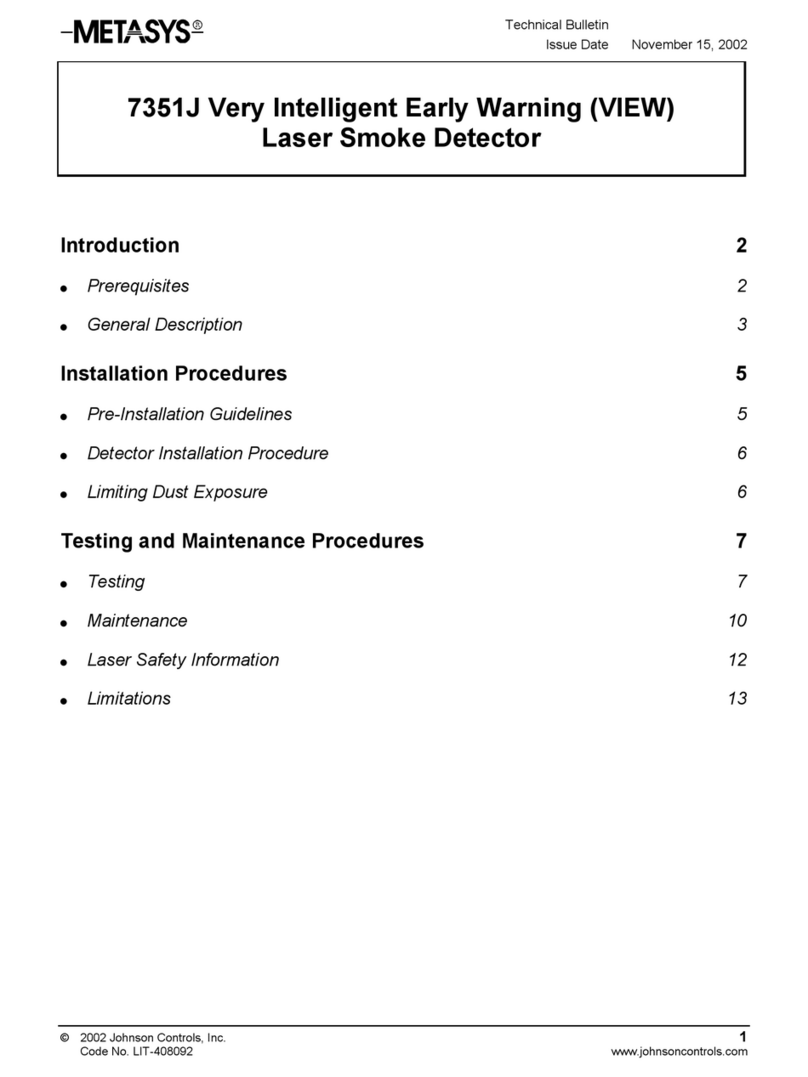
Metasys
Metasys 7351J Service manual
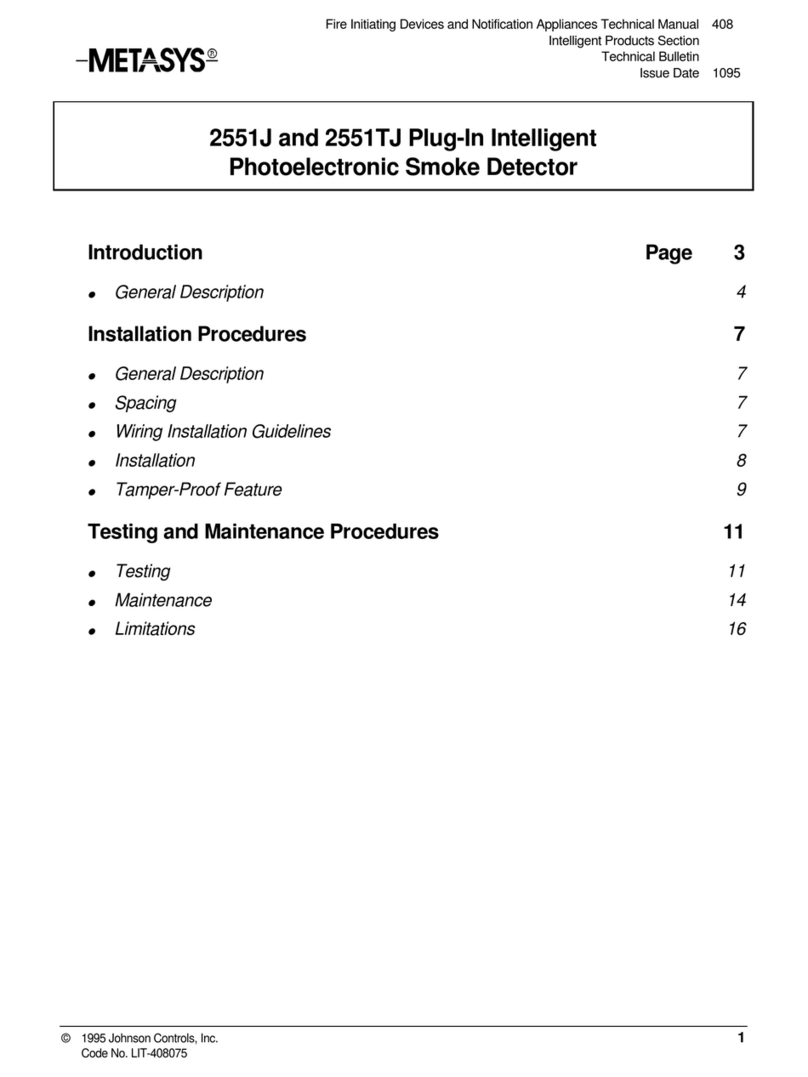
Metasys
Metasys 2551J User manual

Metasys
Metasys 2412AT User manual

Metasys
Metasys 1400 User manual

Metasys
Metasys 1551J User manual
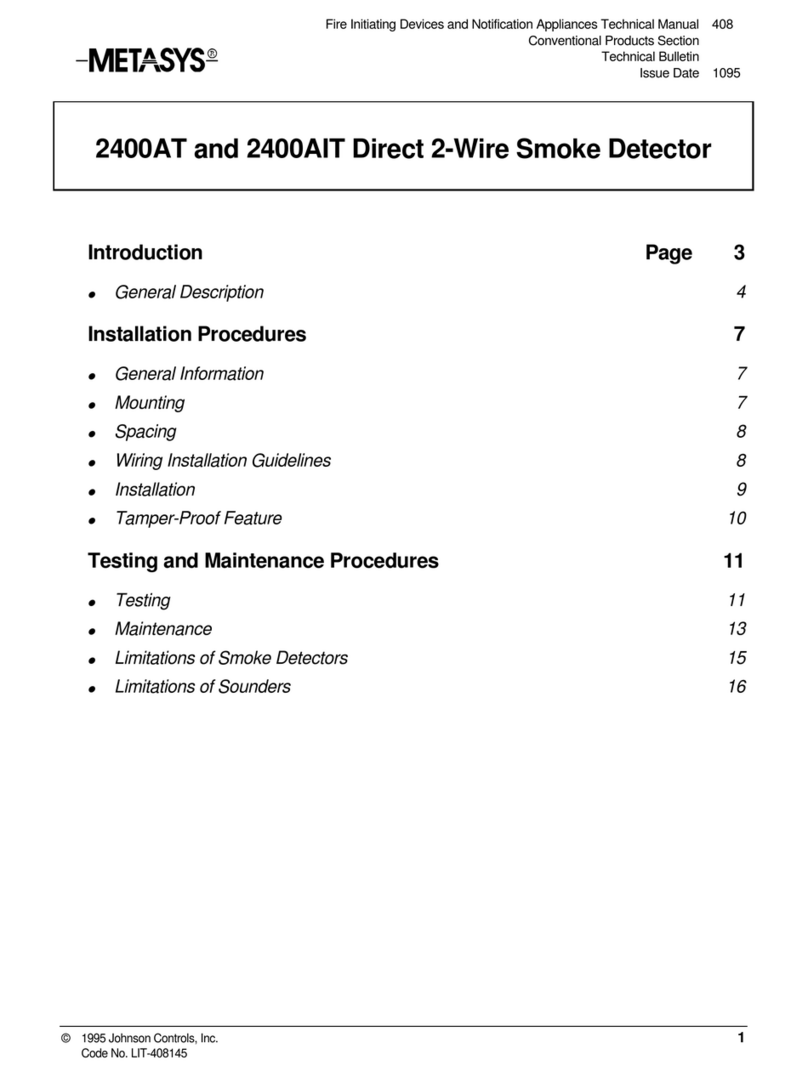
Metasys
Metasys 2400AT Service manual
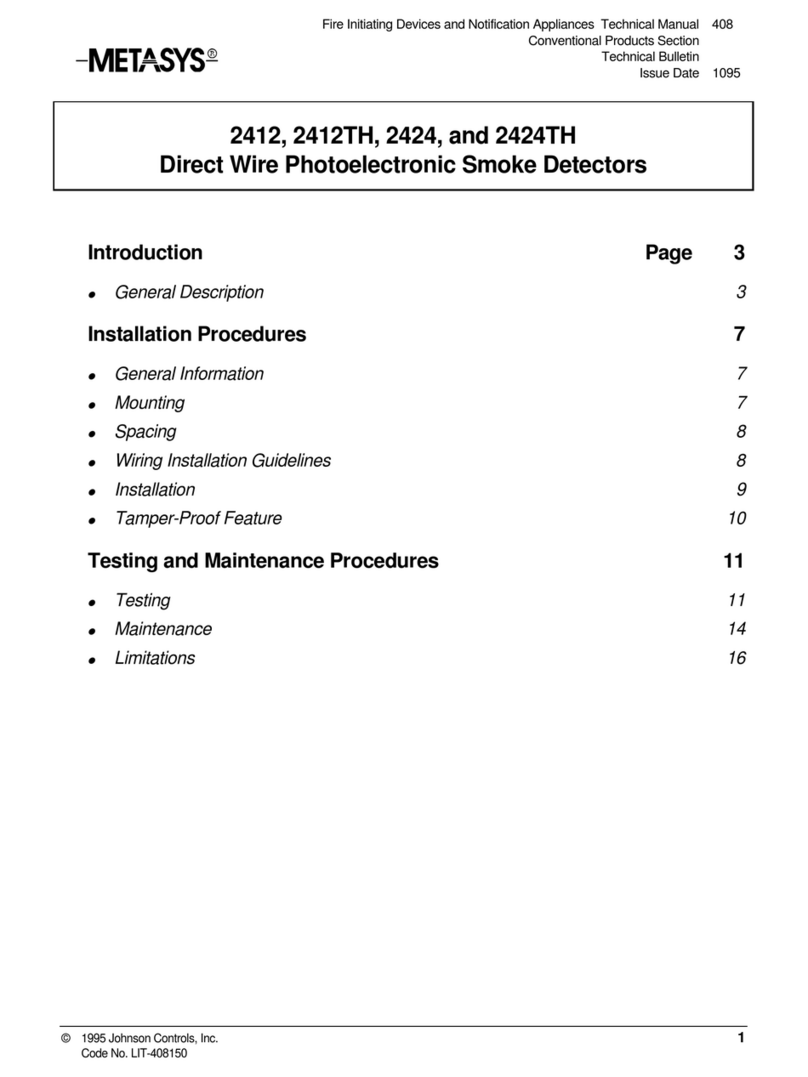
Metasys
Metasys 2412 Series Service manual
Popular Smoke Alarm manuals by other brands

IKEA
IKEA VAKTA manual
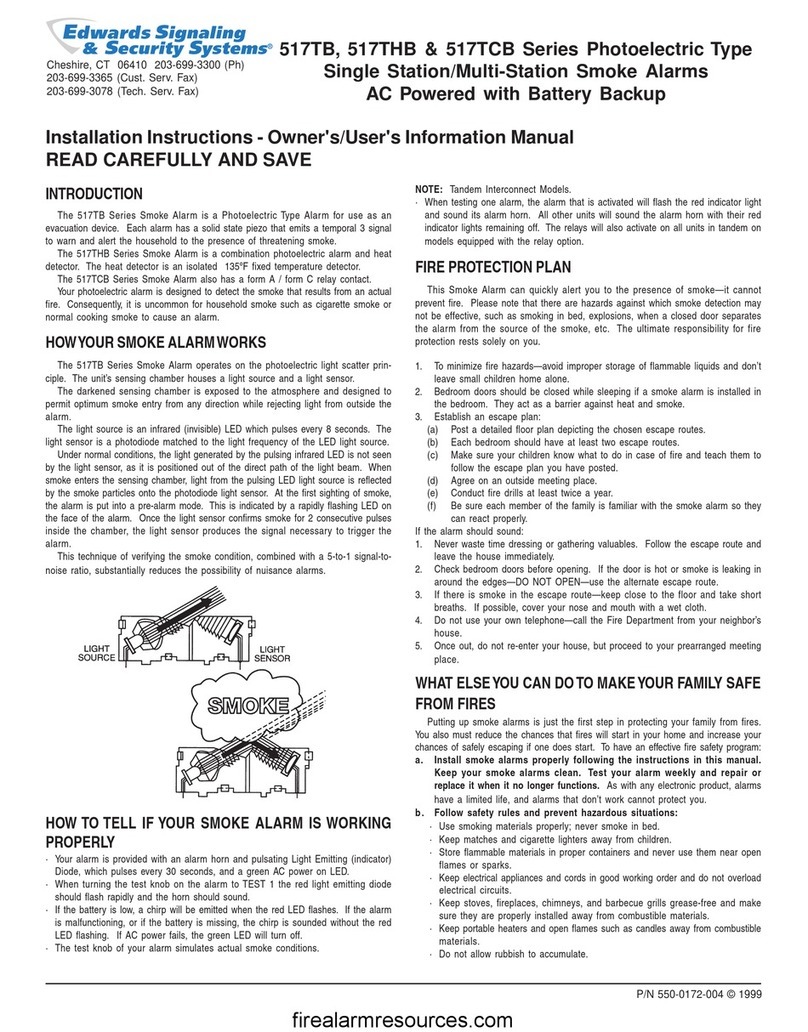
Edwards Signaling & Security Systems
Edwards Signaling & Security Systems 517TB Series installation instructions
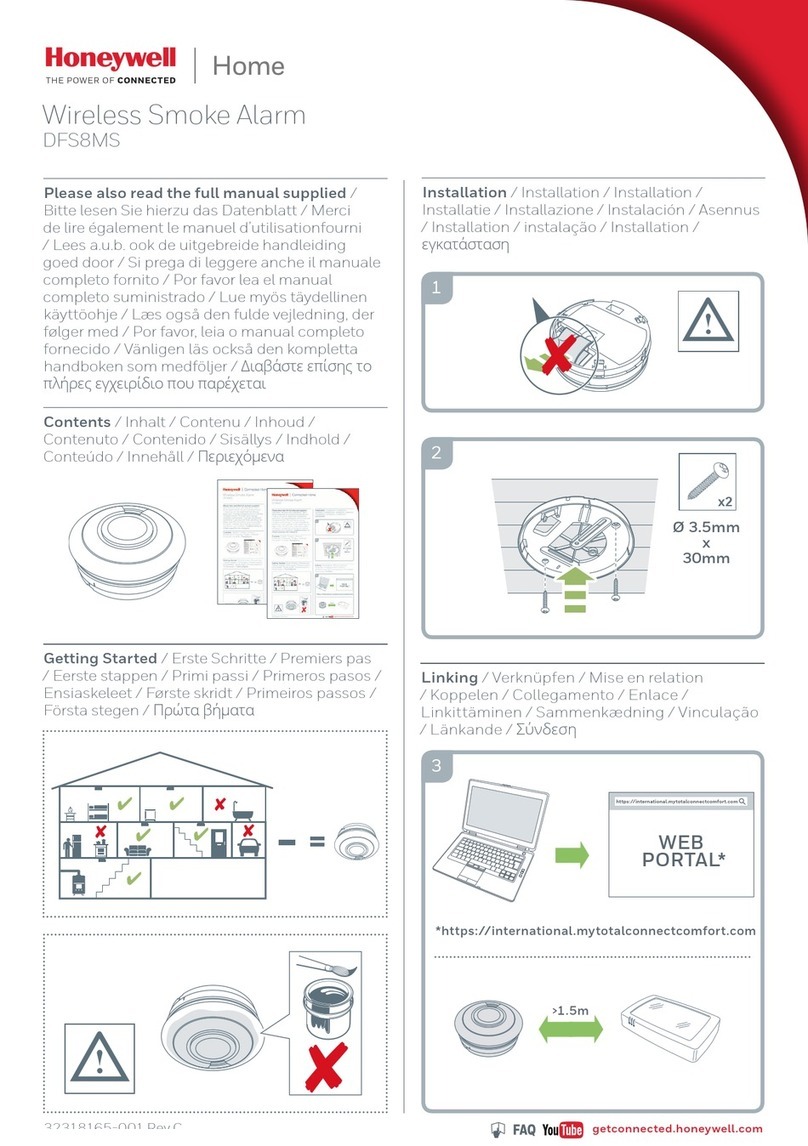
Honeywell
Honeywell DFS8MS manual

Masterbuilt
Masterbuilt MB20053418 manual
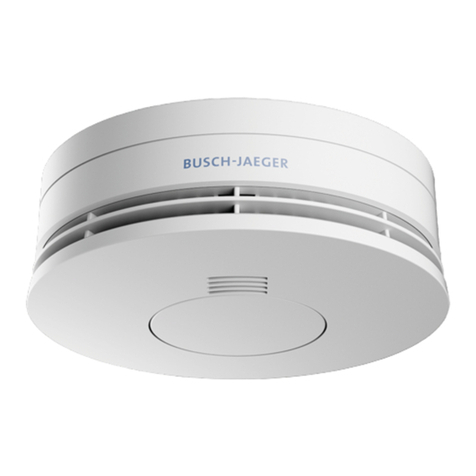
Busch-Jaeger
Busch-Jaeger Busch-Rauchalarm 6831-84 manual
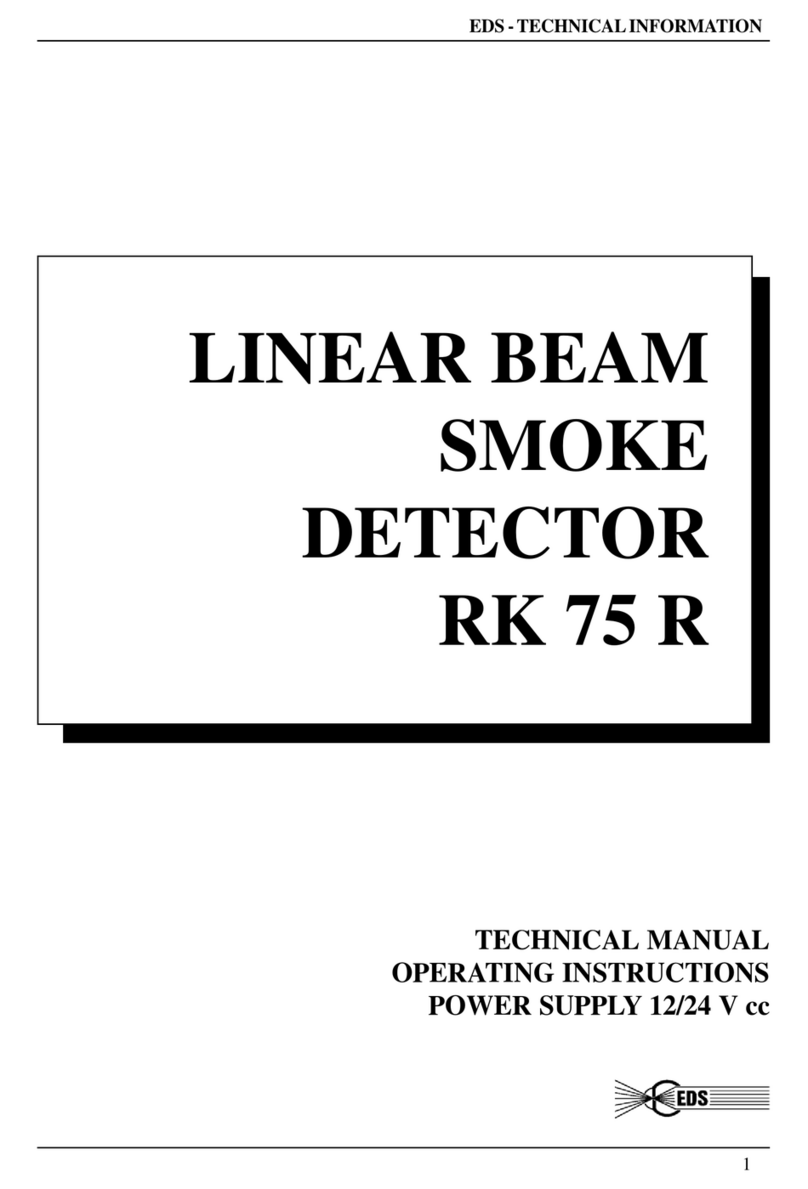
EDS
EDS RK 75 R TECHNICAL MANUAL OPERATING INSTRUCTIONS
